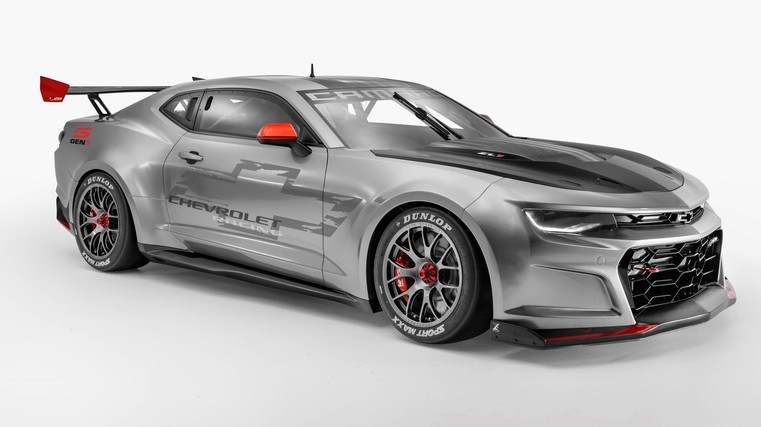Reigniting Camaro racing legend

Chevrolet Racing describes itself as the new heart for fans who followed and celebrated more than 50 years of Holden success in touring-car racing.
As the future motorsports brand for General Motors Australia and New Zealand, it sits alongside the company’s other business units GM Specialty Vehicles (GMSV), Holden Certified Service, GM Trade Parts and ACDelco.
It describes the new Gen3 Chevrolet Camaro ZL1 for Supercars racing as “the boldest of the breed”, and it has reignited one of the oldest rivalries in Australian motorsport – Chevrolet versus Ford and Camaro against Mustang.
The ZL1 is the result of a collaboration between Supercars, Triple Eight Race Engineering and GM. It will signal an exciting future direction for the sport when it hits the track for the first race of the 2023 championship season.
Fresh from completing the design of the next-generation Camaro for Nascar, GM’s design team in Detroit is also responsible for the overall appearance of the racer for Australia. Similar cues are evident in their muscular appearance and unmistakable resemblance to their roadgoing equivalents.
As a successor to the Holden legacy, the Camaro nameplate is new to Supercars, but not new to touring-car racing and neither is its rivalry with the Mustang.
In 1971, tyre magnate Bob Jane used an imported Camaro to claim the Australian Touring Car Championship (ATCC) in an epic shoot-out with Allan Moffat in his Mustang at the Oran Park circuit in Sydney.
Jane and the Camaro, also wearing the classic ZL1 badge, did the job again the following year as touring-car fans were treated to some of the most intense and exciting racing in the history of Australian motorsport.
The Gen3 regulations will reignite that classic battle with the same brands and badges, but with a new generation of star drivers at the wheel.
“The look and sound of the Gen3 Camaro is incredible,” says Marc Ebolo, managing director of GM Australia and New Zealand. “The passion and excitement of success on the track has been such an important part of our Holden brand DNA for so long.”
The announcement is particularly timely with GMSV just celebrating 12 months of operation in Australasia.

About the ZL1
The Gen3 technical regulations called for significant changes and a fresh approach to Chevrolet’s new Supercars contender – the prototype is pictured above.
One of the most important was for the Camaro Supercar to accurately reflect the aesthetics of the regular roadgoing Chevrolet Camaro ZL1.
Work on the project has been handled by Triple Eight Race Engineering working closely with the GM Design and Racing division in North America.
Chevrolet’s powertrain componentry is a core element of Holden’s success in motorsport and this philosophy continues with the Gen3 Camaro Supercar.
Powering it from the family of the GM aluminium small block engines is Chevrolet Racing’s 5.7-litre LTR V8 engine. Homologation partner KRE Race Engines is tasked with its development and this work will continue throughout 2022.
The engine has undergone early testing and track laps through 2021 in a heavily camouflaged mule car, and nothing can disguise its V8 soundtrack.
Racing stock
Holden has been a winner in the ATCC and at Bathurst for more than 50 years.
In 1970, “Stormin” Norm Beechey took his iconic yellow HT Monaro GTS350 to a famous ATCC victory, the first for a locally built Holden.
On the way to the title, he also won at Mount Panorama. It was Holden against the rest, including the Mustang, Camaro and even the underdog Porsche 911.
Beechey’s greatest competitors were often driving Fords, and it was Allan Moffat who became the ultimate rival for Holden fans when he wheeled out his Trans Am Mustang and Falcon.
The competitors took a “no-prisoners approach” to racing, swapping paint and denting panels with a colourful line-up of Monaros, Camaros and Mustangs.
Times and vehicles might have changed since the first Holden victory in the ATCC more than five decades ago, but the Red Lion brand was represented through all the different eras of Australian touring-car racing.
From showroom-based series production vehicles through to the heavily modified Group C era of locally developed cars and onto the international Group A regulations, followed by a return to the Australia-first V8 Supercars and now Supercars, Holden has competed around the world.
Over the years and generations, Holden teams have taken more than 20 combined ATCC and Supercar championship series wins.
Holden has also been dominant at Bathurst in The Great Race each October with 34 wins in the Bathurst 500 and 1000. Its cars vehicles scored many more wins on The Mountain than any other manufacturer, with Ford trailing in second with 20.
Camaro-Mustang rivalry
As one chapter in Supercars closes, another opens and 2021 was the 50th anniversary of the first Camaro victory in 1971’s ATCC, but the nameplate has been a winning part of Australia’s motorsport scene for longer than that.
Bob Jane won back-to-back championships with his Camaro, but he wasn’t the first to race the vehicle across the Tasman because Melbourne driver Terry Allen competed in a Camaro SS in 1967.
Many more racers soon saw the potential in the big American coupe and, in 1968, Beechey replaced his crowd-favourite Chevrolet Nova with a Camaro SS and fellow Victorian Bryan Thomson joined the switch in 1969.
But it was Jane who raised the bar – in a big way – in late 1970 when he imported two 1969 Camaro ZL1s as the basis for his assault on the 1971 ATCC.
Only 69 of these race-only special machines were built by Chevrolet and sold by a limited number of dealers for competition-only use in circuit and drag racing.
What made the Camaro that Jane raced special was a lightweight bodyshell that, in combination with a powerful lightweight big-block Chevrolet V8, delivered a fabulous power-to-weight ratio.
The Camaro’s performance advantage was reinforced with front disc brakes, firmer suspension and four-speed Muncie M21/22 gearboxes driving through a 12-bolt posi-traction limited-slip differential.
The Camaro’s ZL1 engine was a spin-off from GM’s attack on the Can-Am sports-car racing series with Jim Hall’s radical Chaparral team.
The all-aluminium seven-litre V8 boasted 321kW, and had big-block performance and small-block weight. The ZL1’s powerplant in combination with the chassis features was always going to make it hard for the opposition.
After the ZL1 had arrived in Melbourne, with distinctive orange bodywork and chassis number 610732, it was “Australianised” to the local converted improved-production regulations at Bob Jane Racing in Sydney Road, Brunswick.
The beast broke cover in early 1971 when it raced in the Tasman Series meeting for visiting Formula One stars at Sandown International Raceway in Melbourne. It was the start of a fierce rivalry between Jane in his Camaro and Allan Moffat in his Mustang as they swapped paint over two races in a prelude to their future rivalry.
Jane won both races and the duo were notably quicker than reigning 1971 champion Norm Beechey in his Monaro GTS350. Jane’s winning form over Moffat was a teaser to the spectacular year’s success that was to come.
The 1971 ATTC started at Symmons Plains Raceway near Launceston in Tasmania. After six hard-fought rounds, the final one loomed at Sydney’s Oran Park.
Moffat and his Mustang led the points score after three round wins, while Jane was a close second after two victories.
The title decider was a battle royal between the pair. Moffat led early on before a gear-selection issue slowed him for a few laps and Jane took the lead in front of more than 30,000 spectators.
Jane withstood Moffat as they battled through lapped traffic and, as the last lap started, the Mustang had closed to the Camaro’s back.
But Jane was up to the task and, as they entered the main straight for the start of the final lap, he unleashed the power of the big-block Chevy V8 and eased away from the Mustang. At the finish line, the Camaro wasn’t much more than one metre ahead.

Jane and his Camaro ZL1, pictured above, had taken the title with three round wins, finishing on 43 points from Moffat with 37 and third-placed Ian “Pete” Geoghegan on 36 in another Mustang. The 1971 season signalled that the Camaro-Mustang rivalry was well and truly under way.
It was a great win but as Jane and his team prepared to defend the title in 1972, the governing body of motorsport across the ditch – then called CAMS and now Motorsport Australia – changed the regulations to reduce the maximum engine capacity to six litres, forcing a change to the Jane’s Camaro.
For the 1972 season, it was downsized to a 5.7-litre small-block Chevrolet V8 as Jane’s opposition, including Moffat, believed the Camaro would be easier to beat without the aluminium 427 that worked so well in 1971.
The smaller 350 didn’t make the towering numbers of the 427, but it didn’t make much impact on the competitiveness of the Camaro. Jane had a car that was just as well-balanced and, with more engine revs, he continued to make the pace.
As time would prove, the result for 1972 was just the same when the rubber hit the track with Jane and his Camaro taking four wins from eight championship rounds to claim the title.
However, 1972 was the end of the improved-production era as a new set of regulations – focusing on the locally built Holdens and Fords – were introduced. This was Group C, with many local modifications as the great battles came to an end. For the time being, anyway.
Even so, the Camaro name continued to be a big part of the Australian motorsport scene through to the mid-1980s thanks to “Revvin” Kevin Bartlett and his cashed-up backer, media mogul Kerry Packer.
Bartlett used his bold-blue Camaro, wearing the unique Channel 9 logo from Packer’s television network, to take the fight to champions including Peter Brock from the Holden Dealer Team, Dick Johnson in a series of Ford Falcons, and Allan Moffat and his giant-killing rotary-engined Mazda RX-7.
Bartlett and the Camaro were always competitive against the best, and a highlight was the combination taking pole position at Bathurst in 1981 before famously rolling the big coupe at the top of the mountain in 1982 after a puncture.
The Gen3 Supercar programme is new, but Chevrolet’s Camaro has a rich and proven heritage in Australian touring-car racing. It’s with much excitement and anticipation that the iconic American muscle car makes a welcome arrival in Supercars.
Pictured below is Kevin Bartlett driving his Camaro at Bathurst in 1981 in 9 Sports livery.






